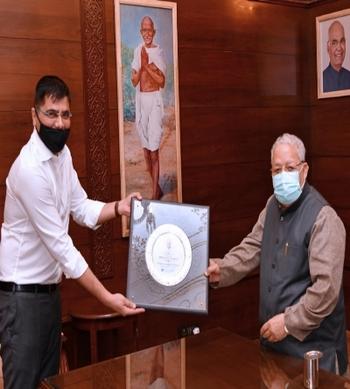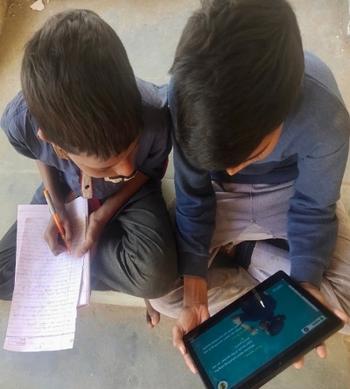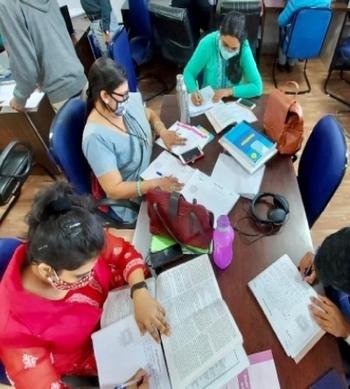CBSE Class 11 Accountancy Syllabus 2022-2023
This article contains the CBSE Class 11 Accountancy Syllabus 2022-2023. Students can view and download the revised and condensed curriculum in PDF format by following the link provided below. This syllabus is useful for understanding the course structure and material proposed by the board for the current academic session. Students will also learn about the project work for the CBSE Class 11th Accountancy topic. This syllabus also includes the question paper design for the CBSE Class 11 Accountancy Annual Exam 2022-23. As a result, in order to design an effective study plan and perform well in their exams, students must properly understand their Accountancy course.
Skip to
Check out the CBSE Class 11 Accountancy (Code No.055) Course Structure 2022-23:
Theory: 80 Marks Time: 3 Hours | ||
Units | Periods | Marks |
Part A: Financial Accounting-1 |
|
|
Unit-1: Theoretical Framework | 25 | 12 |
Unit-2: Accounting Process | 115 | 44 |
Part B: Financial Accounting-II |
|
|
Unit-3: Financial Statements of Sole Proprietorship | 60 | 24 |
Part C: Project Work | 20 | 20 |
Download CBSE Class 11th Accountancy Syllabus
PART A: FINANCIAL ACCOUNTING - I
Unit-1: Theoretical Frame Work
Units/Topics | Learning Outcomes |
Introduction to Accounting · l Accounting- concept, meaning, as a source of information, objectives, advantages and limitations, types of accounting information; users of accounting information and their needs. Qualitative Characteristics of Accounting Information. Role of Accounting in Business. · l Basic Accounting Terms- Entity, Business Transaction, Capital, Drawings. Liabilities (Non Current and Current). Assets (Non Current, Current); Expenditure (Capital and Revenue), Expense, Revenue, Income, Profit, Gain, Loss, Purchase, Sales, Goods, Stock, Debtor, Creditor, Voucher, Discount (Trade discount and Cash Discount) Theory Base of Accounting l Fundamental accounting assumptions: GAAP: Concept · l Basic accounting concept : Business Entity, Money Measurement, Going Concern, Accounting Period, Cost Concept, Dual Aspect, Revenue Recognition, Matching, Full Disclosure, Consistency, Conservatism, Materiality and Objectivity · l System of Accounting. Basis of Accounting: cash basis and accrual basis · l Accounting Standards: Applicability in IndAS · l Goods and Services Tax (GST): Characteristics and Advantages. | After going through this Unit, the students will be able to: · l describe the meaning, significance, objectives, advantages and limitations of accounting in the modem economic environment with varied types of business and non-business economic entities. l identify / recognise the individual(s) and entities that use accounting information for serving their needs of decision making. · l explain the various terms used in accounting and differentiate between different related terms like current and non-current, capital and revenue. · l give examples of terms like business transaction, liabilities, assets, expenditure and purchases. · l explain that sales/purchases include both cash and credit sales/purchases relating to the accounting year. l differentiate among income, profits and gains. · state the meaning of fundamental accounting assumptions and their relevance in accounting. l describe the meaning of accounting assumptions and the situation in which an assumption is applied during the accounting process. · l explain the meaning, applicability, objectives, advantages and limitations of accounting standards. · l appreciate that various accounting standards developed nationally and globally are in practice for bringing parity in the accounting treatment of different items. · l acknowledge the fact that recording of accounting transactions follows double entry system. · l explain the bases of recording accounting transaction and to appreciate that accrual basis is a better basis for depicting the correct financial position of an enterprise. l Explain the meaning, advantages and characteristic of GST. |
Unit-2: Accounting Process
Units/Topics | Learning Outcomes |
Recording of Business Transactions · l Voucher and Transactions: Source documents and Vouchers, Preparation of Vouchers, Accounting Equation Approach: Meaning and Analysis, Rules of Debit and Credit. · l Recording of Transactions: Books of Original Entry- Journal · l Special Purpose books: · l Cash Book: Simple, cash book with bank column and petty cashbook l Purchases book · l Sales book · l Purchases return book · l Sales return book · l Journal proper Note: Including trade discount, freight and cartage expenses for simple GST calculation. · l Ledger: Format, Posting from journal and subsidiary books, Balancing of accounts Bank Reconciliation Statement: · l Need and preparation, Bank Reconciliation Statement Depreciation, Provisions and Reserves · l Depreciation: Meaning, Features, Need, Causes, factors· l Other similar terms: Depletion and Amortisation · l Methods of Depreciation: i. Straight Line Method (SLM) ii. Written Down Value Method (WDV) Note: Excluding change of method · l Difference between SLM and WDV; Advantages of SLM and WDV · l Method of recoding depreciation i. Charging to asset account ii. Creating provision for depreciation/accumulated depreciation account l Treatment of disposal of asset · l Provisions, Reserves, Difference Between Provisions and Reserves. · l Types of Reserves: i. Revenue reserve ii. Capital reserve iii. General reserve iv. Specific reserve v. Secret Reserve · l Difference between capital and revenue reserve Trial balance and Rectification of Errors · l Trial balance: objectives, meaning and preparation (Scope: Trial balance with balance method only) l Errors: classification-errors of omission, commission, principles, and compensating; their effect on Trial Balance. · l Detection and rectification of errors; (i) Errors which do not affect trial balance (ii) Errors which affect trial balance · l preparation of suspense account. | After going through this Unit, the students will be able to: · l explain the concept of accounting equation and appreciate that every transaction affects either both the sides of the equation or a positive effect on one item and a negative effect on another item on the same side of accounting equation. · l explain the effect of a transaction (increase or decrease) on the assets, liabilities, capital, revenue and expenses. l appreciate that on the basis of source documents, accounting vouchers are prepared for recording transaction in the books of accounts. · l develop the understanding of recording of transactions in journal and the skill of calculating GST. · l explain the purpose of maintaining a Cash Book and develop the skill of preparing the format of different types of cash books and the method of recording cash transactions in Cash book. · l describe the method of recording transactions other than cash transactions as per their nature in different subsidiary books . · l appreciate that at times bank balance as indicated by cash book is different from the bank balance as shown by the pass book / bank statement and to reconcile both the balances, bank reconciliation statement is prepared. l develop understanding of preparing bank reconciliation statement. · l appreciate that for ascertaining the position of individual accounts, transactions are posted from subsidiary books and journal proper into the concerned accounts in the ledger and develop the skill of ledger posting. · l explain the necessity of providing depreciation and develop the skill of using different methods for computing depreciation. · l understand the accounting treatment of providing depreciation directly to the concerned asset account or by creating provision for depreciation account. · l appreciate the method of asset disposal through the concerned asset account or by preparing asset disposal account. · l appreciate the need for creating reserves and also making provisions for events which may belong to the current year but may happen in next year. · l appreciate the difference between reserve and reserve fund. · l state the need and objectives of preparing trial balance and develop the skill of preparing trial balance. · l appreciate that errors may be committed during the process of accounting. · l understand the meaning of different types of errors and their effect on trial balance. · l develop the skill of identification and location of errors and their rectification and preparation of suspense account. |
Part B: Financial Accounting - II
Unit 3: Financial Statements of Sole Proprietorship
Units/Topics | Learning Outcomes |
Financial Statements Meaning, objectives and importance; Revenue and Capital Receipts; Revenue and Capital Expenditure; Deferred Revenue expenditure. Opening journal entry. Trading and Profit and Loss Account: Gross Profit, Operating profit and Net profit. Preparation. Balance Sheet: need, grouping and marshalling of assets and liabilities. Preparation. Adjustments in preparation of financial statements with respect to closing stock, outstanding expenses, prepaid expenses, accrued income, income received in advance, depreciation, bad debts, provision for doubtful debts, provision for discount on debtors, Abnormal loss, Goods taken for personal use/staff welfare, interest on capital and managers commission. Preparation of Trading and Profit and Loss account and Balance Sheet of a sole proprietorship with adjustments. | After going through this Unit, the students will be able to: · l state the meaning of financial statements l purpose of preparing financial statements. l state the meaning of gross profit, operating profit and net profit and develop the skill of preparing trading and profit and loss account. · l explain the need for preparing balance sheet. · l understand the technique of grouping and marshalling of assets and liabilities. · l appreciate that there may be certain items other than those shown in trial balance which may need adjustments while preparing financial statements. · l develop the understanding and skill to do adjustments for items and their presentation in financial statements like depreciation, closing stock, provisions, abnormal loss etc. · l develop the skill of preparation of trading and profit and loss account and balance sheet. |
Part C: Project Work (Any One)
1. Collection of source documents, preparation of vouchers, recording of transactions with the help of vouchers.
2. Preparation of Bank Reconciliation Statement with the given cash book and the pass book with twenty to twenty-five transactions.
3. Comprehensive project of any sole proprietorship business. This may state with journal entries and their ledgering, preparation of Trial balance. Trading and Profit and Loss Account and Balance Sheet. Expenses, incomes and profit (loss), assets and liabilities are to be depicted using pie chart / bar diagram.Conclusion
The CBSE (Central Board of Secondary Education) Class 11 Accountancy syllabus provides students with a strong foundation in basic accounting principles and concepts. The syllabus is designed to help students develop their understanding of financial accounting, analyze and interpret financial statements, and gain practical knowledge of recording transactions. By studying the Class 11 Accountancy syllabus, students will learn about various accounting terms, rules, and processes that are essential for maintaining accurate financial records. They will also explore topics such as the accounting equation, journal entries, ledger posting, trial balance, and financial statements like the income statement and balance sheet.
FAQs
1.What is the duration of the CBSE Class 11 Accountancy exam?
The duration of the CBSE Class 11 Accountancy exam is generally three hours
2.Are there any practical components in the Class 11 Accountancy syllabus?
The CBSE Class 11 Accountancy syllabus includes practical components, such as recording transactions in journal and ledger, preparation of trial balance, and the presentation of financial statements
3.Is the Class 11 Accountancy syllabus challenging?
The difficulty level of the Class 11 Accountancy syllabus can vary from student to student. However, with regular practice, understanding of concepts, and proper guidance, students can excel in the subject.
4.Is it necessary to study Class 11 Accountancy for commerce students?
Accountancy is a core subject for commerce students. It provides a foundation for understanding financial transactions, analyzing financial statements, and pursuing higher studies or careers in finance, accounting, or business.
Download CBSE Class 11th Accountancy Syllabus PDF

MissionGyan Team
We aim to eradicate the education gap and serve equal and free education to all with the help of skilled and expert volunteers and teachers.





